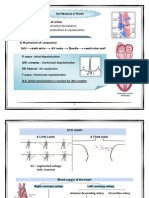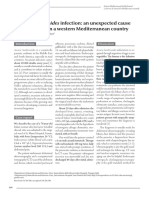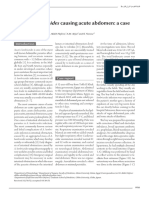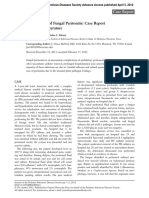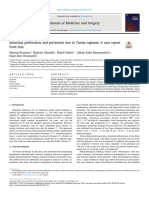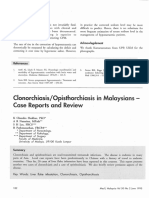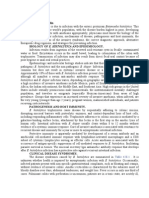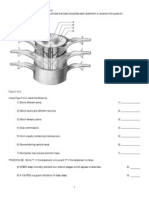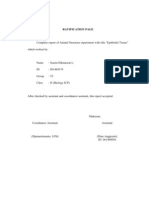0 ratings0% found this document useful (0 votes)
19 views16 3 2010 0350 0351 PDF
16 3 2010 0350 0351 PDF
Uploaded by
Sandi Apriadi1. A 78-year-old Italian woman presented with fever, abdominal pain, and pancreatitis. Imaging revealed pancreatic swelling and fluid in the abdomen and lungs.
2. She underwent surgery to address the pancreatitis, but later developed eosinophilia and vomited an Ascaris lumbricoides worm. Treatment with an anti-parasitic drug resolved her symptoms.
3. While ascariasis is common in the Mediterranean, this case highlights how the worm can unexpectedly cause severe illness like pancreatitis, even in non-travelers, through local contamination of vegetables or soil. The presence of eosinophilia should have earlier suggested a parasitic infection.
Copyright:
© All Rights Reserved
Available Formats
Download as PDF, TXT or read online from Scribd
16 3 2010 0350 0351 PDF
16 3 2010 0350 0351 PDF
Uploaded by
Sandi Apriadi0 ratings0% found this document useful (0 votes)
19 views2 pages1. A 78-year-old Italian woman presented with fever, abdominal pain, and pancreatitis. Imaging revealed pancreatic swelling and fluid in the abdomen and lungs.
2. She underwent surgery to address the pancreatitis, but later developed eosinophilia and vomited an Ascaris lumbricoides worm. Treatment with an anti-parasitic drug resolved her symptoms.
3. While ascariasis is common in the Mediterranean, this case highlights how the worm can unexpectedly cause severe illness like pancreatitis, even in non-travelers, through local contamination of vegetables or soil. The presence of eosinophilia should have earlier suggested a parasitic infection.
Original Title
16_3_2010_0350_0351.pdf
Copyright
© © All Rights Reserved
Available Formats
PDF, TXT or read online from Scribd
Share this document
Did you find this document useful?
Is this content inappropriate?
1. A 78-year-old Italian woman presented with fever, abdominal pain, and pancreatitis. Imaging revealed pancreatic swelling and fluid in the abdomen and lungs.
2. She underwent surgery to address the pancreatitis, but later developed eosinophilia and vomited an Ascaris lumbricoides worm. Treatment with an anti-parasitic drug resolved her symptoms.
3. While ascariasis is common in the Mediterranean, this case highlights how the worm can unexpectedly cause severe illness like pancreatitis, even in non-travelers, through local contamination of vegetables or soil. The presence of eosinophilia should have earlier suggested a parasitic infection.
Copyright:
© All Rights Reserved
Available Formats
Download as PDF, TXT or read online from Scribd
Download as pdf or txt
0 ratings0% found this document useful (0 votes)
19 views2 pages16 3 2010 0350 0351 PDF
16 3 2010 0350 0351 PDF
Uploaded by
Sandi Apriadi1. A 78-year-old Italian woman presented with fever, abdominal pain, and pancreatitis. Imaging revealed pancreatic swelling and fluid in the abdomen and lungs.
2. She underwent surgery to address the pancreatitis, but later developed eosinophilia and vomited an Ascaris lumbricoides worm. Treatment with an anti-parasitic drug resolved her symptoms.
3. While ascariasis is common in the Mediterranean, this case highlights how the worm can unexpectedly cause severe illness like pancreatitis, even in non-travelers, through local contamination of vegetables or soil. The presence of eosinophilia should have earlier suggested a parasitic infection.
Copyright:
© All Rights Reserved
Available Formats
Download as PDF, TXT or read online from Scribd
Download as pdf or txt
You are on page 1of 2
EMHJ Vol. 16 No.
3 2010 Eastern Mediterranean Health Journal
La Revue de Sant de la Mditerrane orientale
350
Case report
Ascaris lumbricoides infection: an unexpected cause
of pancreatitis in a western Mediterranean country
A. Galzerano,
1
E. Sabatini
1
and D. Dur
2
1
Department of Anaesthesia and Intensive Care, Santa Maria della Misericordia Hospital, Perugia, Italy.
2
Department of Anaesthesia and Intensive Care, Sant Antonio Hospital, San Daniele del Friuli, Italy (Correspondence to D. Dur: dav.anestesia@
gmail.com).
Received: 13/01/08; accepted: 09/03/08
Introduction
Ascaris lumbricoides is a nematode
parasite, endemic in the Middle East
and South America, especially in rural
countries. Ascariasis infection causes
about 20 000 deaths every year [1],
usually as a result of intestinal occlusion,
and it contributes to infant malnutri-
tion [2]. Poor sanitation is usually the
most important risk factor for infection,
and women are more afected because
progesterone plays a role in inducing
Oddis sphincter relaxation, allowing
the nematode to access the biliary duct
[3]. Although not common in devel-
oped countries, ascariasis infection is
increasingly likely to be encountered by
clinicians because of the growing rates
of travel to developing countries and
increased migration.
Case report
We describe the case of a 78-year-old
Italian woman who had never travelled
abroad, who was admited to the surgi-
cal ward of A. Murri Hospital, Fermo,
Italy, with fever (temperature 38 C),
leukocytosis (white blood cell count
15.4 10
3
/L), hyperamylasaemia
(serum amylase level 260 U/L) and
abdominal pain.
Te patient underwent abdominal
ultrasonography and a computerized
tomography (CT) scan of the abdomen
and thorax, which revealed peritoneal
efusion, pancreatic oedema, dilated
gallbladder with a bile duct measuring
1.1 cm with no lithiasis, lef pleural efu-
sion and basal atelectasis. Endoscopic
retrograde cholangiopancreatography
showed a dilated bile duct with a patent
ampulla with no lithiasis.
Te day afer admission the patient
underwent cholecystectomy, cholan-
giogram, positioning of Kher drainage
and pancreatic necrosectomy. Due to
haemodynamic instability and respira-
tory failure the patient was then admited
to the intensive care unit. At admission
she was apyretic and microbiological
cultures from abdominal drainage spec-
imens were negative. Afer weaning and
extubation the patient was transferred to
the surgical ward where she underwent
an unremarkable recovery.
About 20 days afer admission she
developed fever, nausea, vomiting,
marked eosinophilia that had not been
noticed before (total leukocyte count
11.8 10
3
/L, eosinophils 10%) and a
maculopapular rash. On the hypothesis
of iatrogenic allergic dermatitis, ster-
oid and antihistamine treatments were
started, with no beneft.
One week later the patient vomited
a 5 cm male ascarid nematode. Terapy
with mebendazole 100 mg twice daily
was started with prompt resolution of
the pancreatic oedema, as documented
by CT scans. Te patients subsequent
recovery was uneventful and she was
discharged 48 days afer initial admis-
sion.
Discussion
Ascaris lumbricoides infestation is ac-
quired through ingestion of eggs in raw
vegetables. Te human is the defnitive
host. Ingested larvae penetrate the intes-
tinal lymphatic and venous vessels and
through the portal vein reach the right
heart, pulmonary circulation and the
alveoli. Afer alveolar rupture they pass
into the trachea and the pharynx, are
then swallowed; afer about 2 months
they reach maturity. In the bowel
nematodes can perforate the intestinal
wall, be ejected from the mouth or anus
and penetrate the biliary ducts or the
airways. Te infestation can present as
a wide range of symptoms: intestinal
perforation or occlusion, cholangitis,
obstructive jaundice, acute pancreatitis
or appendicitis, pneumonia and respira-
tory failure and allergic reactions to the
ascaris antigen. In most cases, however,
patients present with unspecifc symp-
toms and sometimes the diagnosis is
incidental [3].
Te diagnosis is usually made by
abdominal ultrasonography, revealing
biliary duct dilation and the presence
of the parasite, a hyperechoic linear
structure with a hypoechogenic line in-
side, which is sometimes motile [35].
Ultrasonography is also the gold stand-
ard technique for follow-up. CT scan
and nuclear magnetic resonance im-
aging can also be helpful. Endoscopic
retrograde cholangiopancreatogra-
phy is the gold standard method for
351
identifying and removing the nematode
from the duodenal, biliary or pancreatic
tract [3].
In this case neither CT scans nor
endoscopic retrograde cholangiopan-
creatography was able to reveal the
presence of the parasite, which probably
had already migrated to the lef lung,
causing basal atelectasis and pleural
Khuroo MS. Ascariasis. 1. Gastroenterology clinics of North Ameri-
ca, 1996, 25:55377.
Villamizar E et al. 2. Ascaris lumbricoides infestation as a cause of
intestinal obstruction in children: experience with 87 cases.
Journal of pediatric surgery, 1996, 31:2014.
Misra SP, Dwivedi M. Clinical features and management of 3.
biliary ascariasis in a non-endemic area. Postgraduate medical
journal, 2000, 76:2932.
Hoffmann H et al. 4. In vivo and in vitro studies on the sonographi-
cal detection of Ascaris lumbricoides. Pediatric radiology, 1997,
27:2269.
Ferreyra NP, Cerri GG. Ascariasis of the alimentary tract, liver, 5.
pancreas and biliary system: its diagnosis by ultrasonography.
Hepatogastroenterology, 1998, 45:9327.
Petit A et al. Lascaridiose: une cause dangiocholite peu 6.
banale sous nos climats [Ascariasis: an unusual cause of cho-
References
langitis in our climate]. Gastroentrologie clinique et biologique,
1991, 15:6601.
Moulinier C, Battin J, Giap G. Evolution du taux de prevalence 7.
de quatre parasites intestinaux chez lenfant [Development
of the prevalence rate of four intestinal parasites in children].
Pediatrie, 1990, 45:12932.
Mosiello G et al. Ascaridiasi come possibile causa di addo- 8.
me acuto anche in Italia: presentazione di un caso clinico
[Ascariasis as a cause of acute abdomen: a case report]. La
pediatria medica e chirurgica, 2003, 25:4524.
De la Cruz Alvarez J et al. Ascariasis biliopancretica: una en- 9.
tida infrecuente en nuestro medio [Biliopancreatic ascariasis:
an infrequent disease in our environment]. Gastroenterologa y
hepatologa, 1996, 19:2102.
efusion at the time the examinations
were made.
Although ascariasis is the most
common human worm infection in the
Mediterranean area, the development of
a severe illness such as a pancreatitis due
to this infestation is unusual [69]. Te
origin of the infestation was not estab-
lished. As the patient had not travelled
to any endemic areas, our hypothesis is a
contact with eggs through consumption
of raw vegetables or contaminated soil.
Te presence of eosinophilia should
have raised suspicion of the possibility
of a parasitic infection, even in a patient
not travelling or migrating from endemic
areas, but the rarity of this cause of acute
abdomen was certainly misleading.
You might also like
- ECG-Dr.Allam منقول PDFDocument11 pagesECG-Dr.Allam منقول PDFRaouf Ra'fat Soliman100% (2)
- TB of The TestesDocument2 pagesTB of The Testesntambik21No ratings yet
- (F) Chapter 16 - Digestive System I, Oral Cavity and Associated StructuresDocument5 pages(F) Chapter 16 - Digestive System I, Oral Cavity and Associated StructuresAisle Malibiran PalerNo ratings yet
- 16 3 2010 0350 0351 PDFDocument2 pages16 3 2010 0350 0351 PDFAustine OsaweNo ratings yet
- Mesenteric Cyst Infected With: Salmonella TyphimuriumDocument2 pagesMesenteric Cyst Infected With: Salmonella TyphimuriumAbhishek Soham SatpathyNo ratings yet
- Ascaris & AscariasisDocument3 pagesAscaris & AscariasisansfdmdnNo ratings yet
- Case Report: Author DetailsDocument3 pagesCase Report: Author DetailsInternational Journal of Clinical and Biomedical Research (IJCBR)No ratings yet
- Activity # 2 - Santos, Aira Kristelle M.Document9 pagesActivity # 2 - Santos, Aira Kristelle M.Ai MendozaNo ratings yet
- Does A Tuberculosis Peritonitis Imitate An Advanced Ovarian Cancer?: A Case Report at Iringa Regional Referral Hospital in TanzaniaDocument4 pagesDoes A Tuberculosis Peritonitis Imitate An Advanced Ovarian Cancer?: A Case Report at Iringa Regional Referral Hospital in TanzaniaInternational Journal of Innovative Science and Research TechnologyNo ratings yet
- 231 PDFDocument12 pages231 PDFAgus KarsetiyonoNo ratings yet
- Infectious IleoceicitisDocument2 pagesInfectious IleoceicitisYandiNo ratings yet
- Jpids Pis043 FullDocument3 pagesJpids Pis043 FullRani Eva DewiNo ratings yet
- Treatment and Prevention of Urogenital Disease in RabbitsDocument5 pagesTreatment and Prevention of Urogenital Disease in RabbitsAjey DiwanNo ratings yet
- Tuberculous Ileal Perforation in Post-Appendicectomy PeriOperative Period: A Diagnostic ChallengeDocument3 pagesTuberculous Ileal Perforation in Post-Appendicectomy PeriOperative Period: A Diagnostic ChallengeIOSRjournalNo ratings yet
- Bedah - Prekas AppendisitisDocument15 pagesBedah - Prekas AppendisitisALfianca Yudha RachmandaNo ratings yet
- Annals of Medicine and SurgeryDocument3 pagesAnnals of Medicine and SurgeryTiti PermatasariNo ratings yet
- Dialnet ReporteDeCaso 8584573Document7 pagesDialnet ReporteDeCaso 8584573Astrid VélizNo ratings yet
- Clonorchiasis OpisthorchiasisDocument5 pagesClonorchiasis OpisthorchiasispranajiNo ratings yet
- Gastritis y SarcinaDocument5 pagesGastritis y SarcinaDayana FajardoNo ratings yet
- Perforación Vesical Espontánea - Una Complicación Rara de La TuberculosisDocument3 pagesPerforación Vesical Espontánea - Una Complicación Rara de La Tuberculosisjudith paz villegasNo ratings yet
- Yersinia Enterocolitica: A Rare Cause of Infective EndocarditisDocument3 pagesYersinia Enterocolitica: A Rare Cause of Infective EndocarditisDIEGO FERNANDO TULCAN SILVANo ratings yet
- Appendicitis ManuscriptDocument4 pagesAppendicitis Manuscriptkint manlangitNo ratings yet
- AnnGastroenterol 24 137Document3 pagesAnnGastroenterol 24 137Abhishek Soham SatpathyNo ratings yet
- Approach For Diagnostic and Treatment of Chronic Diarrhea Caused by Hookworm InfectionDocument7 pagesApproach For Diagnostic and Treatment of Chronic Diarrhea Caused by Hookworm InfectionRianda AkmalNo ratings yet
- Case Report Aditya - Jurnal VancoverDocument6 pagesCase Report Aditya - Jurnal VancoverAditya AirlanggaNo ratings yet
- Krukenberg Tumour Simulating Uterine Fibroids and Pelvic Inflammatory DiseaseDocument3 pagesKrukenberg Tumour Simulating Uterine Fibroids and Pelvic Inflammatory DiseaseradianrendratukanNo ratings yet
- A Me Bias IsDocument5 pagesA Me Bias IsRavinder NainawatNo ratings yet
- Case Study - Septic AbortionDocument4 pagesCase Study - Septic AbortionHoneylyn100% (1)
- Congenital Umblical Fistula in An Adult Female: Case ReportDocument3 pagesCongenital Umblical Fistula in An Adult Female: Case ReportRaihan LuthfiNo ratings yet
- Colovesical Fistula PDFDocument4 pagesColovesical Fistula PDFWilliam WiryawanNo ratings yet
- Primary Aortoenteric FistulaDocument5 pagesPrimary Aortoenteric FistulaKintrili AthinaNo ratings yet
- Research Article: ISSN: 0975-833XDocument2 pagesResearch Article: ISSN: 0975-833XnidaatsNo ratings yet
- Peritonitis: Presentan: FAUZAN AKBAR YUSYAHADI - 12100118191Document21 pagesPeritonitis: Presentan: FAUZAN AKBAR YUSYAHADI - 12100118191Fauzan Fourro100% (1)
- Appendicitis: Mark W. Jones Hassam Zulfiqar Jeffrey G. DeppenDocument7 pagesAppendicitis: Mark W. Jones Hassam Zulfiqar Jeffrey G. DeppenAndi HairunNo ratings yet
- Infected Urachal Cyst in An Adult A Case Report and Review of The LiteratureDocument3 pagesInfected Urachal Cyst in An Adult A Case Report and Review of The LiteratureAhmad Ulil AlbabNo ratings yet
- Clostridium Tetani Bacteraemia: Case ReportDocument2 pagesClostridium Tetani Bacteraemia: Case ReportSandy TauvicNo ratings yet
- 260-Article Text-875-1-10-20220728Document4 pages260-Article Text-875-1-10-20220728hasan andrianNo ratings yet
- Symptomatic Shigella Sonnei Urinary Tract InfectionDocument2 pagesSymptomatic Shigella Sonnei Urinary Tract Infectionramzi syamlanNo ratings yet
- Parasitology Question and AnswersDocument22 pagesParasitology Question and Answersofficialmwalusamba100% (1)
- Typhoid Fever,-WPS OfficeDocument5 pagesTyphoid Fever,-WPS OfficeElvisNo ratings yet
- 03 2019 Asp NewsletterDocument8 pages03 2019 Asp NewsletterBenjamin ChackoNo ratings yet
- PIIS1198743X14627877Document1 pagePIIS1198743X14627877MEHMEET KAURNo ratings yet
- AfrJPaediatrSurg5265-5010858 012330 PDFDocument6 pagesAfrJPaediatrSurg5265-5010858 012330 PDFSandi ApriadiNo ratings yet
- K-4 PR - Soil Transmitted HelminthiasisDocument45 pagesK-4 PR - Soil Transmitted HelminthiasissantayohanaNo ratings yet
- Journal of Clinical and Translational Endocrinology: Case ReportsDocument5 pagesJournal of Clinical and Translational Endocrinology: Case ReportsKartikaa YantiiNo ratings yet
- Clinical Predictors of Ileocecal Tuberculosis: A Case SeriesDocument14 pagesClinical Predictors of Ileocecal Tuberculosis: A Case SeriesChristopher AsisNo ratings yet
- Artigo 18Document6 pagesArtigo 18Pâmela BuenoNo ratings yet
- Managementul Postoperator in Sindromul Intestinului Scurt Caz ClinicDocument2 pagesManagementul Postoperator in Sindromul Intestinului Scurt Caz ClinicA D ANo ratings yet
- A Rare Case of Emphysematous Gastritis With Partial Gut Malrotation - Managed ConservativelyDocument4 pagesA Rare Case of Emphysematous Gastritis With Partial Gut Malrotation - Managed ConservativelyIJAR JOURNALNo ratings yet
- 1 PBDocument9 pages1 PBMariiaNo ratings yet
- Images For Surgeons: Abdominal Tuberculosis: An Easily Forgotten DiagnosisDocument2 pagesImages For Surgeons: Abdominal Tuberculosis: An Easily Forgotten DiagnosisRisti Khafidah100% (1)
- Spontaneous Perforated Pyometra With An Intrauterine Device in Menopause: A Case ReportDocument2 pagesSpontaneous Perforated Pyometra With An Intrauterine Device in Menopause: A Case ReportTomy SaputraNo ratings yet
- Providencia InfectionsDocument2 pagesProvidencia InfectionsEllagEszNo ratings yet
- Scardoso, 182004 - ENDocument5 pagesScardoso, 182004 - ENslashmiller.u2No ratings yet
- Intra-Abdominal and Pelvic EmergenciesDocument21 pagesIntra-Abdominal and Pelvic Emergenciesqhrn48psvwNo ratings yet
- Jejunojejunal Intussusception As Initial Presentation of Coeliac Disease: A Case Report and Review of LiteratureDocument6 pagesJejunojejunal Intussusception As Initial Presentation of Coeliac Disease: A Case Report and Review of Literatureellya theresiaNo ratings yet
- Angio Strong Yl UsDocument29 pagesAngio Strong Yl UsayaamrsharfNo ratings yet
- 1 s2.0 S1743919113000307 Main PDFDocument5 pages1 s2.0 S1743919113000307 Main PDFkunkkonkNo ratings yet
- Case Files® EnterococcusDocument4 pagesCase Files® EnterococcusAHMAD ADE SAPUTRANo ratings yet
- 2013 1 5 PDFDocument2 pages2013 1 5 PDF04lubna_869632400No ratings yet
- Comprehensive Insights into Gastroenteritis: Pathogenesis, Management, and Future DirectionsFrom EverandComprehensive Insights into Gastroenteritis: Pathogenesis, Management, and Future DirectionsNo ratings yet
- Pediatric Appendicitis: Navigating Pathways of Understanding and InnovationFrom EverandPediatric Appendicitis: Navigating Pathways of Understanding and InnovationNo ratings yet
- Pros 2012 04C MP Herman PDFDocument16 pagesPros 2012 04C MP Herman PDFSandi ApriadiNo ratings yet
- Narrowing Socioeconomic Inequality in Child Stunting The PDFDocument7 pagesNarrowing Socioeconomic Inequality in Child Stunting The PDFSandi ApriadiNo ratings yet
- AfrJPaediatrSurg5265-5010858 012330 PDFDocument6 pagesAfrJPaediatrSurg5265-5010858 012330 PDFSandi ApriadiNo ratings yet
- Age Patterns in Undernutrition and Helminth Infection in A Rural Area of Brazil: Associations With Ascariasis and HookwormDocument10 pagesAge Patterns in Undernutrition and Helminth Infection in A Rural Area of Brazil: Associations With Ascariasis and HookwormSandi ApriadiNo ratings yet
- Comparison cdc2000 PDFDocument2 pagesComparison cdc2000 PDFSandi ApriadiNo ratings yet
- DVSDGVFSDocument1 pageDVSDGVFSSandi ApriadiNo ratings yet
- 137 265 1 SM PDFDocument7 pages137 265 1 SM PDFSandi ApriadiNo ratings yet
- DVDFVGFDVGDocument1 pageDVDFVGFDVGSandi ApriadiNo ratings yet
- DVDFVGDZJHFVJDocument1 pageDVDFVGDZJHFVJSandi ApriadiNo ratings yet
- Pay Per ClickDocument6 pagesPay Per ClickSandi ApriadiNo ratings yet
- Syog3a QPDocument21 pagesSyog3a QPMargret pastina PNo ratings yet
- Glandular EpitheliumDocument10 pagesGlandular EpitheliumAbby Claire SomeraNo ratings yet
- CP (Sub-Grp)Document79 pagesCP (Sub-Grp)Pamela laquindanumNo ratings yet
- Anger Part 2Document2 pagesAnger Part 2Laura AndreiNo ratings yet
- Chapter 12Document7 pagesChapter 12joshkxNo ratings yet
- Fetal Pig DissectionDocument14 pagesFetal Pig Dissectionrangerblue86% (7)
- CNS - Limbic SystemDocument46 pagesCNS - Limbic SystemsarvinaNo ratings yet
- Excretion Chapter NotesDocument7 pagesExcretion Chapter NotesMohammad Sayed AliNo ratings yet
- Anatomy and Physiology MouthDocument4 pagesAnatomy and Physiology MouthAndrew BimbusNo ratings yet
- Week 1 Respiratory SystemDocument9 pagesWeek 1 Respiratory SystemCarl Brian L. MonteverdeNo ratings yet
- Jabba JabbaDocument49 pagesJabba JabbaCombustible DragonNo ratings yet
- Felixcharlie Electrolyte Homeostasis Part 3Document3 pagesFelixcharlie Electrolyte Homeostasis Part 3Nur Fatima SanaaniNo ratings yet
- CH 18 Casestudy With Worksheet-2Document2 pagesCH 18 Casestudy With Worksheet-2Yanitza Yanez0% (1)
- Report of Epithelial TissueDocument38 pagesReport of Epithelial Tissuerheny_green100% (2)
- Siri 4 Modul Heroin Biologi Bab 8-15 TG4 GuruDocument17 pagesSiri 4 Modul Heroin Biologi Bab 8-15 TG4 GuruharyantoNo ratings yet
- Section2 - 13 Thyroid Disease in PregnancyDocument10 pagesSection2 - 13 Thyroid Disease in PregnancyJashveerBediNo ratings yet
- Nervous Tissue: Prof. Dr. Anas Sarwar QureshiDocument12 pagesNervous Tissue: Prof. Dr. Anas Sarwar QureshiShafaqat Ghani Shafaqat GhaniNo ratings yet
- Medical Examination FormDocument2 pagesMedical Examination Formyasharman789No ratings yet
- CT AbdoDocument2 pagesCT AbdoDR NIKNo ratings yet
- Cansuje National High School: Quarter 3 Summative Test No. 1 in Science 10Document3 pagesCansuje National High School: Quarter 3 Summative Test No. 1 in Science 10Jannet FuentesNo ratings yet
- HYPOTHYROIDISMDocument11 pagesHYPOTHYROIDISMVarun SinghNo ratings yet
- 2016 AJKD Volume 67 Issue 2 February (33) HepatorenalDocument11 pages2016 AJKD Volume 67 Issue 2 February (33) HepatorenalAnonymous Yo0mStNo ratings yet
- Elektrokardiogramm) Is A Graphic Produced by An ElectrocardiographDocument5 pagesElektrokardiogramm) Is A Graphic Produced by An ElectrocardiographReverie ManalaysayNo ratings yet
- 2.body Defence Mechanism - Sept 2015Document31 pages2.body Defence Mechanism - Sept 2015sukma100% (1)
- (Gastrointestinal Function) Analysis Report Card: Actual Testing ResultsDocument2 pages(Gastrointestinal Function) Analysis Report Card: Actual Testing ResultsShashikanth RamamurthyNo ratings yet
- Breast Disorder: by DR - Wael MetwalyDocument7 pagesBreast Disorder: by DR - Wael MetwalyhasebeNo ratings yet
- WORKSHEET 12.4: Reflex Arc: Name: - Chapter 12 Coordination and ResponseDocument3 pagesWORKSHEET 12.4: Reflex Arc: Name: - Chapter 12 Coordination and ResponseVinNo ratings yet
- Jurnal Sistem Pencernaan Pada ManusiaDocument5 pagesJurnal Sistem Pencernaan Pada ManusiaJeannete Claudia WulandariNo ratings yet
